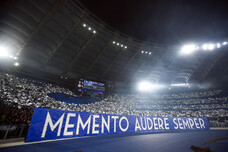(see related story) The 14th-century project for the doors of the Florence Baptistery foresaw all of the doors in the same format, with stories organised in 28 squares containing Gothic quatrefoils.
However, a series of events, including the Black Death in 1348, changed the plans of the powerful merchants' guild Arte di Calimala, which had commissioned the massive doors of the baptistery.
The result were three masterpieces in bronze and gold, created not as planned, one after the other, but over the course of more than a century.
The first set of doors in the Gothic style was made by Andrea Pisano, while the two sets to follow were made during the Renaissance by Lorenzo Ghiberti, who devoted his entire life to the project.
Ghiberti was only 23 years old when, in 1401, he won the contest to make the first of his two sets, beating out even Brunelleschi.
He completed the second set when he was in his seventies.
That set is the extraordinary Gates of Paradise, whose collaborators also included Donatello, Michelozzo, Benozzo Gozzoli, and Paolo Uccello.
The oldest of the doors, the south doors, were created by Andrea Pisano between 1330 and 1336.
The doors are massive, weighing about eight tons, and measuring 4.94 metres tall and 2.95 metres wide.
Viewers are left enchanted by the attention to detail and care devoted to the gilded sculptures on the 28 panels, 20 of which tell episodes from the life of St. John the Baptist, patron saint of the Baptistery and of Florence.
It wasn't until 1402, however, that work began on the second set of doors, the north doors, measuring five metres tall and three metres wide, and weighing nine tons.
Ghiberti completed that set in 1424, and it is considered the work that opened the season of the Renaissance.
Ghiberti took up the scheme from the south doors, but his style, in nearly 20 years of work, evolved from the Gothic of the first scenes to the Renaissance of the last.
The 14th-century project changed radically with the Gates of Paradise, which kept Ghiberti busy for 27 years.
The artist eliminated the quatrefoils and reduced the panels to 10, in which he depicted various episodes from the Old Testament, as well as a frieze composed of 48 elements, including his self-portrait.
ALL RIGHTS RESERVED © Copyright ANSA











